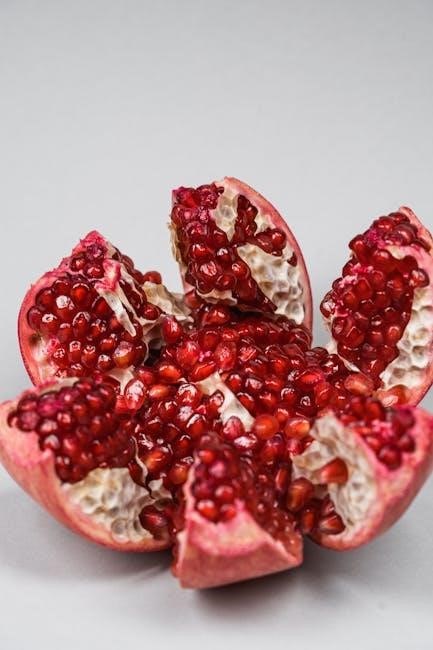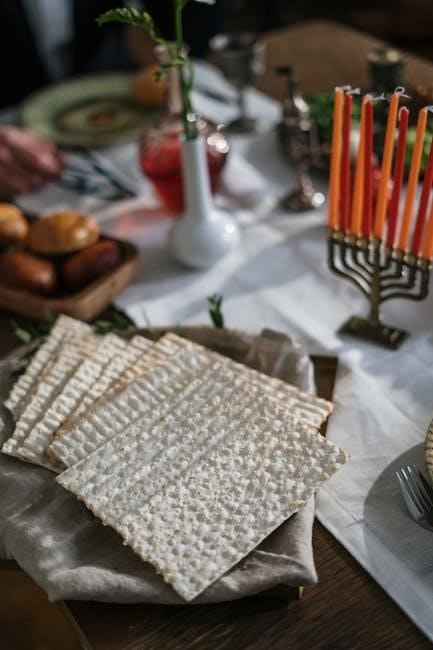The Rosh Hashanah Seder is an ancient custom rooted in Talmudic tradition‚ offering a meaningful way to welcome the new year with symbolic foods and blessings. A Rosh Hashanah Seder PDF serves as a guide‚ providing the order of blessings‚ explanations of symbolic foods‚ and helpful instructions for conducting the seder at home. This resource enhances the experience‚ making it accessible and engaging for all participants.
What is Rosh Hashanah?
Rosh Hashanah‚ the Jewish New Year‚ marks the beginning of the High Holy Days‚ a period of reflection and renewal. It is celebrated on the first and second days of the Hebrew month of Tishrei. The holiday is a time for prayer‚ introspection‚ and rejoicing‚ as Jews around the world seek forgiveness and blessings for the coming year. Central to the observance is the sounding of the shofar‚ a ram’s horn‚ which symbolizes awakening to spiritual growth. Rosh Hashanah also includes festive meals‚ often featuring symbolic foods like apples dipped in honey‚ expressing hopes for a sweet and prosperous year ahead.
The Origins of the Rosh Hashanah Seder
The Rosh Hashanah Seder traces its roots to the Talmud (Horayot 12a)‚ where Rabbi Abaye discusses the significance of symbolic foods and omens. This ancient tradition emphasizes eating foods that symbolize prosperity and good fortune‚ such as dates‚ apples with honey‚ and pomegranates. The Seder is particularly prominent in Sephardic and Mizrahi communities but has gained popularity worldwide. A Rosh Hashanah Seder PDF often includes Talmudic references‚ blessings‚ and explanations of these symbolic foods‚ serving as a guide to enrich the ritual. This meaningful custom connects modern practitioners to Jewish heritage‚ fostering reflection and hope for the new year.

Historical Background of the Rosh Hashanah Seder
The Rosh Hashanah Seder has Talmudic roots‚ evolving over centuries with diverse traditions across Jewish communities. A Rosh Hashanah Seder PDF often includes historical insights‚ preserving this meaningful ritual.
Talmudic Roots and the Significance of Symbolic Foods
The Rosh Hashanah Seder traces its origins to the Talmud‚ where Rabbi Abaye highlights symbolic foods eaten as omens for a prosperous year. These include fenugreek‚ leeks‚ and beets‚ each representing specific blessings;
A Rosh Hashanah Seder PDF often details these traditions‚ explaining how foods like a fish head or ram’s head symbolize leadership and divine intervention‚ reflecting the Binding of Isaac. This practice enriches the holiday‚ blending ancient customs with modern accessibility through digital guides.
Evolution of the Seder Tradition Across Jewish Communities
The Rosh Hashanah Seder tradition‚ while rooted in Talmudic customs‚ has evolved across Jewish communities. Originally prominent in Sephardic and Mizrahi traditions‚ it has gained popularity in Ashkenazi communities in recent years. A Rosh Hashanah Seder PDF often reflects these diverse practices‚ offering variations in blessings‚ food symbolism‚ and rituals. This adaptability ensures the tradition remains vibrant and inclusive‚ bridging ancient customs with modern accessibility. The PDF guide serves as a unifying resource‚ preserving the richness of the Seder while catering to the cultural and linguistic needs of global Jewish communities‚ fostering a sense of unity and shared heritage.

Structure of the Rosh Hashanah Seder
The Rosh Hashanah Seder involves symbolic foods‚ blessings‚ and reflections. A Rosh Hashanah Seder PDF organizes the ceremony‚ providing a clear structure for reciting blessings and understanding the significance of each tradition‚ ensuring an accessible and meaningful experience for all participants.
Key Components of the Seder
The Rosh Hashanah Seder centers on symbolic foods and blessings‚ each carrying specific meanings for the new year. A Rosh Hashanah Seder PDF typically includes a seder plate with items like apples‚ honey‚ and pomegranates‚ accompanied by their blessings. The order of the seder is structured to guide participants through reflections and wishes for the upcoming year. These components are designed to foster gratitude‚ renewal‚ and spiritual connection‚ making the seder a meaningful and accessible experience for all who partake. The PDF often includes prayers‚ transliterations‚ and explanations to ensure everyone can engage fully in the tradition.
The Order of Blessings and Symbolic Foods
The Rosh Hashanah Seder follows a structured sequence of blessings and symbolic foods‚ each representing specific wishes for the new year. A Rosh Hashanah Seder PDF typically outlines this order‚ ensuring participants can follow along seamlessly. Blessings are recited over foods like apples dipped in honey for sweetness‚ pomegranates for abundance‚ and fish heads symbolizing leadership. Each food is eaten after its blessing‚ creating a meaningful rhythm. The PDF often includes transliterations and explanations‚ making the seder accessible to all. This organized approach allows families and communities to reflect on the past year and welcome the new one with intention and gratitude.
Symbolic Foods and Their Meanings
The Rosh Hashanah Seder features symbolic foods like apples with honey for a sweet year‚ pomegranates for abundance‚ and fish heads for leadership. A Rosh Hashanah Seder PDF details these traditions‚ explaining their spiritual significance and connection to New Year blessings.
Traditional Foods and Their Blessings
The Rosh Hashanah Seder incorporates symbolic foods‚ each accompanied by specific blessings. Apples dipped in honey represent a sweet new year‚ while pomegranates symbolize abundance and righteousness. A fish head or roasted head of lettuce signifies leadership. Dates‚ often eaten first‚ express hopes for a year of peace. These foods‚ outlined in a Rosh Hashanah Seder PDF‚ are blessed with traditional prayers‚ such as Baruch Atah Adonai‚ to invoke divine favor. The guide provides Hebrew blessings‚ translations‚ and explanations‚ ensuring participants understand the deeper meaning behind each custom‚ fostering a meaningful and spiritually enriching experience.
The Role of the Rosh Hashanah Seder PDF
A Rosh Hashanah Seder PDF serves as a comprehensive guide‚ offering structured blessings‚ symbolic food explanations‚ and step-by-step instructions. It ensures an organized and meaningful seder experience for all participants;
Why a PDF Guide is Useful for Observing the Seder
A Rosh Hashanah Seder PDF is an invaluable resource for observing the seder‚ providing a structured and accessible format for participants. It includes blessings‚ symbolic food explanations‚ and step-by-step instructions‚ ensuring a meaningful experience. The guide is particularly useful for those unfamiliar with the tradition‚ offering clarity and organization. Additionally‚ it allows for easy sharing and preparation‚ making it ideal for both in-person and virtual gatherings. With its comprehensive content‚ the PDF enhances the spiritual and cultural significance of the seder‚ helping families and communities usher in the new year with intention and joy.

How to Conduct a Rosh Hashanah Seder
Prepare symbolic foods‚ recite blessings‚ and follow the seder order. Use a Rosh Hashanah Seder PDF for guidance‚ ensuring a meaningful and structured experience for all participants.
Step-by-Step Guide to Leading the Seder
Leading a Rosh Hashanah Seder begins with preparing symbolic foods and arranging them on the table. Start by reciting the Kiddush to sanctify the occasion. Use a Rosh Hashanah Seder PDF to guide the order of blessings and explanations of each food’s significance. Invite participants to engage by sharing reflections or wishes for the new year. Ensure everyone partakes in tasting the symbolic items‚ such as apples with honey and round challah‚ to embody hopes for sweetness and renewal; Conclude with heartfelt prayers and a collective commitment to growth in the upcoming year.

Cultural Variations in Rosh Hashanah Seder Practices
The Rosh Hashanah Seder varies significantly across Jewish communities‚ reflecting diverse cultural traditions. Sephardic and Mizrahi communities have long embraced this custom‚ often incorporating unique symbolic foods like dates‚ pomegranates‚ and fish heads. Ashkenazi traditions‚ while less historically associated with the seder‚ are increasingly adopting it. Some families use a head of lettuce as a substitute for the fish head‚ symbolizing leadership and renewal. A Rosh Hashanah Seder PDF often includes these variations‚ offering adaptable rituals for both traditional and modern practices. This flexibility ensures the seder remains meaningful and accessible across cultural and generational boundaries.
The Significance of the Rosh Hashanah Seder in Modern Times
The Rosh Hashanah Seder holds profound significance in modern times as a meaningful way to connect with tradition and community. It offers a reflective space for personal growth‚ gratitude‚ and renewal‚ aligning with contemporary values of mindfulness and intentionality. The use of symbolic foods and blessings encourages families to engage deeply with the holiday’s themes. A Rosh Hashanah Seder PDF provides accessible guidance‚ making the ritual easier to adopt for both experienced and new participants. This ancient custom continues to evolve‚ fostering a sense of unity and spiritual renewal in an increasingly fast-paced world.
